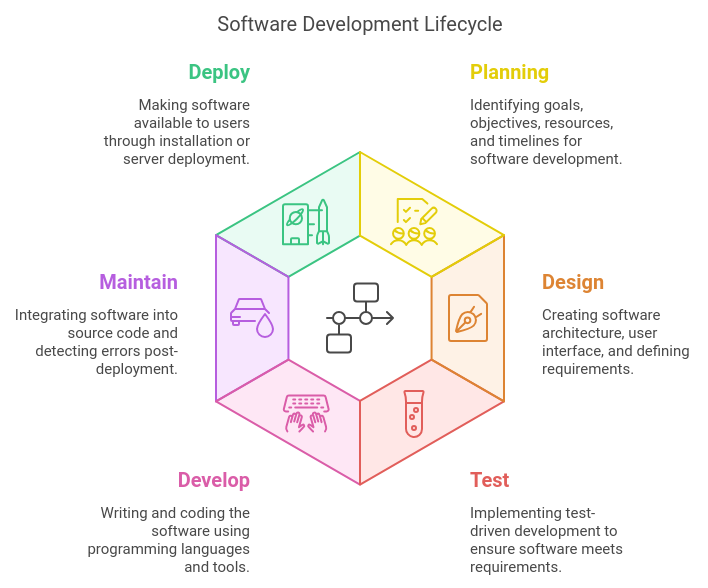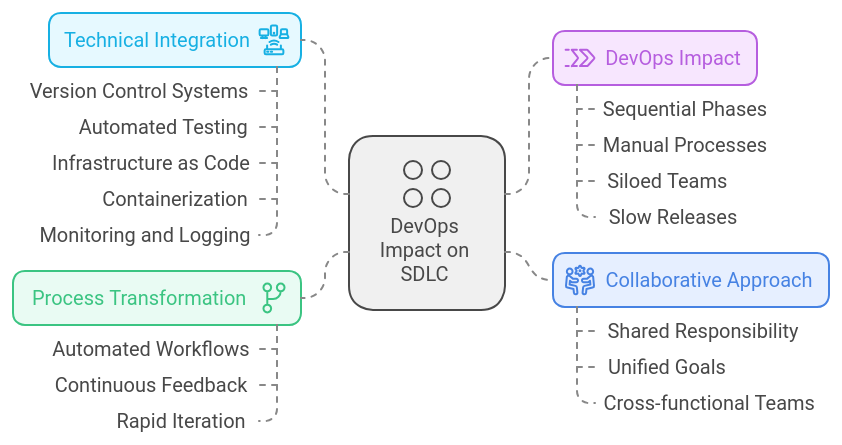Software Lifecycle
Designing code
1 Lifecycle software
And a developer needs such a set skill due to the wide and integral software lifecycle that allows to build apps.
The software development lifecycle (SDLC) is a process that describes the stages involved in creating and deploying software. It typically includes the following six steps:
Planning: This stage involves identifying the goals and objectives of the software, as well as determining the resources and timelines required to develop it.
Design: In this stage, the software’s architecture and user interface are created, and the functional and non-functional requirements are defined.
Test: This stage involves the implementation of test-driven development (TDD). It starts by writing automated test cases based on the requirements and design of the software. The developer then writes the minimum amount of code needed to pass the test, and repeat this process until all the requirements are met.
Develop: The actual coding of the software takes place during this stage. This may involve writing code in a specific programming language or using certain development tools.
Maintain: Once the software is tested and developed, it will be integrated into the primary source code through developer efforts, usually by leveraging training environments to detect further errors or defects.
Deploy: The final stage is deployment, where the software is made available to users. This may involve installing the software on individual computers or deploying it to a server for multiple users to access.
2 Software Development Lifecycle and DevOps Relationship
Core Connection
DevOpsis not a separatelifecycle, but a cultural and technical approach that transforms traditionalsoftware development lifecycle (SDLC)by:
- Breaking down silos between development and operations teams
- Introducing continuous integration and continuous delivery
- Enabling faster, more reliable software deployment
2.1 Key Relationship Aspects
Collaborative Approach
DevOpsfosters a collaborative approach that fundamentally changes how development and operations teams interact. It emphasizes shared responsibility, where both teams are accountable for the entire software lifecycle, from development to deployment and maintenance.
This approach promotes unified goals, aligning the objectives of both teams towards delivering high-quality software efficiently.
Cross-functional team integration is a key aspect, breaking down traditional silos and encouraging continuous communication and knowledge sharing between developers, operations personnel, and other stakeholders.
Process Transformation
At the heart of
DevOpsis a significant transformation of software development and deployment processes. Automated workflows are implemented to streamline repetitive tasks, reduce human error, and increase efficiency.
Continuous feedback loops are established, allowing for rapid identification and resolution of issues throughout the development cycle.
This enables rapid iteration and deployment, where software updates can be released quickly and frequently. The focus shifts from large, infrequent releases to smaller, incremental updates that can be easily rolled back if issues arise.
Technical Integration
DevOpsrelies heavily on technical integration to support its collaborative and efficient approach.
Version control systems are used to manage code changes and facilitate collaboration among developers.
Automated testing is implemented at various stages of the development process to ensure code quality and catch issues early.
Infrastructure as Code (IaC) allows for the management and provisioning of infrastructure through code, ensuring consistency and repeatability.
Containerization technologies like Docker are used to package applications and their dependencies, ensuring consistent behavior across different environments.
Comprehensive monitoring and logging systems are put in place to provide real-time insights into application performance and user behavior, enabling quick responses to issues and informed decision-making.
DevOps Impact on SDLC
Traditional SDLC → DevOps SDLC
Sequential Phases → Continuous Improvement
Manual Processes → Automated Workflows
Siloed Teams → Collaborative Environment
Slow Releases → Rapid, Frequent Deployments2.2 Benefits
- Faster time-to-market
- Improved software quality
- Enhanced team productivity
- Reduced deployment risks
- Increased customer satisfaction

